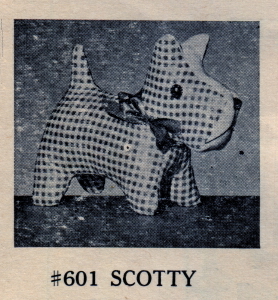Mary Meyer Washable Stuffed Toy Scotty 1946
 Mary Meyer started making stuffed toys in the 1933. My Mother was Mary Meyer and I have a collection of toys she made starting in the 1930s right up to today – 2014.
Mary Meyer started making stuffed toys in the 1933. My Mother was Mary Meyer and I have a collection of toys she made starting in the 1930s right up to today – 2014.
As a kid I watched the “ladies” who made the toys doing all of the different toy making operations.
Stuffing toys in the 1930s and 40s were hand made.
Mary Meyer moved to Vermont in the mid 1940s from just outside New York City in New Jersey.
Up until this point stuffed toys were stuffed by hand mostly with cotton fiber. This was garneted cotton, which came in 2 colors – Dark Blue and Pink. Garneted cotton was made from clean rags which were run through a garneting machine, which took the cotton cloth fabric and tore it apart and returned it to it’s original condition as fluffy cotton batting. The dark blue was made from dark color fabric like denim and the lighter Pink was made from light colored and White cloth.
Mary Meyer used the lighter colored cotton, because the dark blue cotton showed through the fabric of the toys.
The garneted cotton was delivered in 500+ pound compressed bales, which were really difficult to maneuver around.
The cotton bales was put in a corner near the stuffing department and large armfuls of cotton were put in the stuffing department. The stuffers sat around a box of stuffing cotton and stuffed. They each have a empty stuffed toy.
When making a stuffed toy the parts are cut from a piece of fabric and sewn wrong-side-out, then turned right-side-out so the seam would not show. Then the toy is stuffed.
The empty right-side-out toy is called a skin or a shell and in the 1930s and 1940s was stuffed by hand with cotton batting. In a production facility women grabbed a large piece of cotton batting and pushed it into the toy skin with a wooden poker about 12″ long. First they stuffed the head, filling out the top of the head, the nose and then the rest of the head. Then they stuffed the arms and legs and finally the body. The opening in the stuffed toy was usually in the back or bottom of the toy, where the closed opening was difficult to see.
In the 1930s and 1940s a stuffed toy that was washable probably was made of “oil cloth”. If you can’t remember oil cloth, it’s the fabric that was on your grandmother’s kitchen table. It was a cotton fabric with a washable coating on it. Toys made from oil cloth would be washed off and cleaned after a youngster dirtied them.
Oil cloth had it’s good points and bad. It can be cleaned after becoming dirty.
The oil cloth protects the inner stuffing from getting soaking wet and not drying out. Oil cloth is difficult to work with, because it’s stiff and not very flexible. If you sew an oil cloth toy wrong-side-out and want to turn it right-side-out, the stiff fabric makes it difficult to do. It can be done, but it’s not easy.
Once you stuff the toy and want to close the opening through which it was stuffed, the stiff fabric is difficult to sew closed and may tear.
Washable fabric was difficult to find in those days, so you had to put up with oil cloth and try and make it work. After World War2 plastic fabrics came into use.
In 1945 Mary Meyer made a line of washable stuffed toys using oil cloth.
Here is #601 – Scotty – about 7″ long and 5″ high made of Red and White checked oil cloth, stuffed with garneted cotton. The eyes, nose and mouth were felt parts sewn on with Black yarn plus a Red satin neck ribbon. Mary Meyer’s line of oil cloth toys included an Elephant, a Terrier, a Horse, a Lamb and a Giraffe. They were made of oil cloth and stuffed with cotton with similar felt facial features and sold in a retail store for $1.00 or slightly less through out the USA
by Walter Meyer
Mary Meyer’s son
.


Leave a Reply